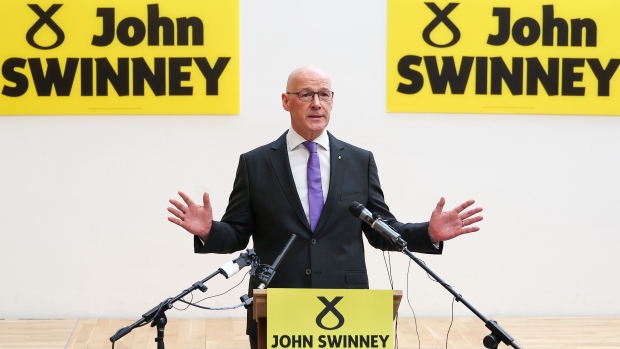May 2, 2024
Scottish Nationalists Look to Old Hand After Leadership Turmoil
, Bloomberg News

(Bloomberg) -- John Swinney had tried to quit front line politics on numerous occasions, he said, by the time he announced he was bowing out last year. Now, it looks like he’s back and facing one of the biggest challenges of his career.
Reeling from the loss of its second leader in a little over a year, the pro-independence Scottish National Party is set to turn to Swinney, 60, to steady the ship. The former deputy first minister is on course to take over after the resignation of Humza Yousaf, who is stepping down as the head of the SNP and Scotland’s semi-autonomous government.
Swinney announced his intention to seek the post earlier on Thursday, while the person considered to be his main challenger, former Finance Secretary Kate Forbes, 34, declined to run. Nominations close on Monday.
Swinney is an old SNP hand, a former leader himself who joined the party as a teenager and went on to run Scotland’s finances and education over the decades. His immediate task will be to limit the damage to his party in a UK election year after a string of scandals and unforced errors.
“I think we’ll face tough times,” he said when announcing his leadership bid. “But I’m stepping up to the plate to sort that.”
Yousaf became leader in March last year following the surprise resignation of Nicola Sturgeon, one of the UK’s most popular politicians. He narrowly beat Forbes after a leadership race that exposed deep divisions in a party that once prided itself on its internal discipline, something senior SNP figures said shouldn’t be repeated.
This week, Yousaf quit after he pulled the SNP out of a power-sharing agreement with the Green Party that left him facing a no-confidence vote he was likely to lose.
But the reality is that the SNP was flailing after a series of policy missteps and reaching a dead end on trying to force the UK to grant another referendum on independence. The SNP is also embroiled in a police investigation into its finances, with Sturgeon’s husband charged with embezzlement.
Swinney was Sturgeon’s right-hand man through the chaos of the UK’s decision to leave the European Union, which Scotland opposed, and the pandemic. He departed from the government in Edinburgh along with Sturgeon. Leaders of the Labour Party and the Conservatives in Scotland both said the SNP was relying on someone who is tainted by previous administrations.
His return shows the scale of the turmoil in what had arguably been the UK’s slickest political machine. Even after the recent mess and 17 years in power in Scotland, the SNP is still neck and neck in the polls with the Labour Party. Critically, the SNP is the third-largest party in the UK Parliament in London and Labour is aiming to benefit.
“We will have to wait and see what difference a new leader makes, and a new first minister makes, and there’s not a whole lot of time between now and a likely general election for them to make a difference,” Nicola McEwen, professor of public policy at the University of Glasgow, said after Yousaf quit. “But we need to be careful not to exaggerate the difficulties that the party is in. They’re still the strongest party in Scotland.”
Born and raised in Edinburgh, Swinney joined the SNP in 1979, the year Margaret Thatcher became UK prime minister. He served as party leader from 2000 to 2004 when the SNP was in opposition in the Scottish Parliament.
He was succeeded by Alex Salmond, who led the SNP into a referendum on independence in 2014. Salmond resigned after Scots chose by 55% to 45% to remain in the UK and Sturgeon took over. She went on to take the SNP to the peak of its powers before quitting — along with Swinney.
“In all that I have undertaken in government, I have tried to listen carefully to different views and be open to the ideas and thoughts of people in Scotland,” Swinney said in his resignation letter last year. Now back to unify his party, Swinney will be listening hard again.
©2024 Bloomberg L.P.